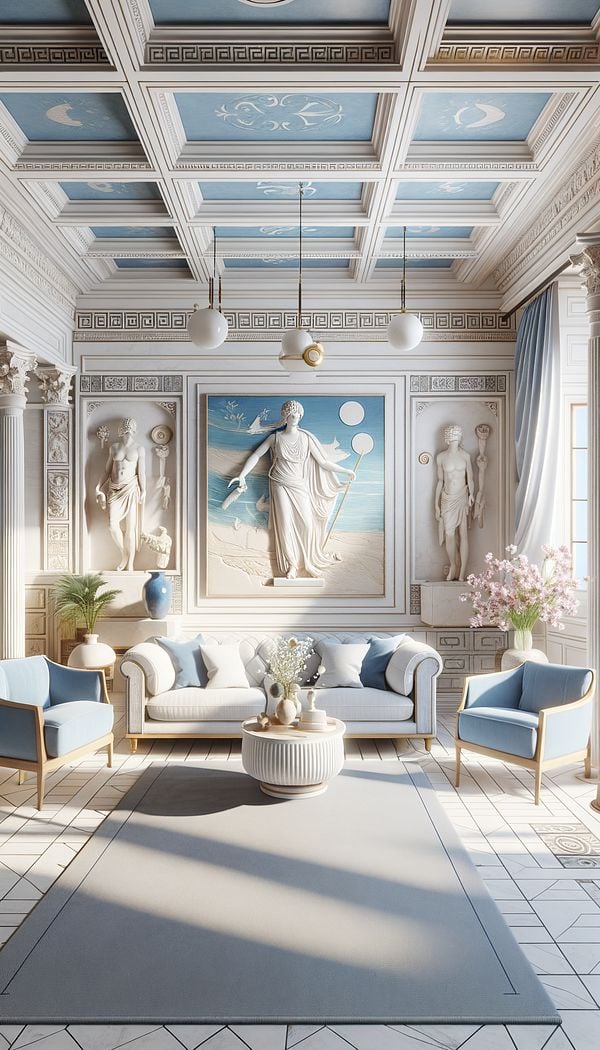What is Greek Style?
Greek Style refers to the design and decoration principles originating from ancient Greece.
Description
Greek Style in interior design represents a homage to the architectural and decorative elements found in ancient Greece, often characterized by its simplicity, harmony, and proportion. This design style is celebrated for its emphasis on symmetry, the use of natural light, and a color palette that mirrors the environment of the Mediterranean - think blues, whites, and earth tones. Architectural elements such as columns, pediments, and friezes are a hallmark of Greek interior design, along with the decorative use of sculptures, pottery, and frescoes that depict mythological and historical themes.
Greek Style often incorporates materials such as marble, terracotta, and wood, providing a sense of luxury and timelessness. Furniture in this style tends to be simple yet sophisticated, with straight lines and often decorated with intricate details like carvings and gilded accents. Textiles play a significant role as well, with the usage of linen and wool in a variety of textures to add warmth and comfort to the space.
The appeal of Greek Style lies in its ability to blend the old with the new, creating spaces that feel both ancient and modern. Its focus on balance and symmetry makes it a versatile design choice that can complement various architectural styles.
Usage
Greek Style is frequently applied in public buildings, such as museums and libraries, to evoke a sense of grandeur and history. It is also popular in residential settings, where elements of the style can be incorporated through architectural details, furniture, and decorative objects. Whether it's through the use of iconic Doric columns in an entryway or adornment with replicas of ancient Greek art, this style creates a refined and cultured atmosphere in any space.
FAQs
-
Can Greek Style be mixed with other interior design styles?
Yes, Greek Style can be elegantly blended with other design styles, such as modern or coastal, to create a unique and personalized space. The key is to maintain a balance between the different elements.
-
Are there any specific colors associated with Greek Style?
Yes, Greek Style often features a color palette inspired by the Mediterranean, including whites, blues, creamy neutrals, and earth tones. These colors contribute to the airy and serene ambiance typical of the style.
-
What type of materials are commonly used in Greek Style interiors?
Materials such as marble, wood, terracotta, and linen are characteristic of Greek Style interiors, offering a mix of luxury, warmth, and natural texture.
-
How can I incorporate Greek Style into a modern home?
Incorporating Greek Style into a modern home can be achieved through the use of symmetrical layouts, classical architectural elements like columns, and decorative pieces such as pottery and sculptures that reflect ancient Greek art and mythology.
-
Is Greek Style suitable for small spaces?
Yes, the simplicity and emphasis on balance and proportion in Greek Style can make small spaces appear larger and more harmonious.
Practical Application
To incorporate Greek Style into your home or project, start with a neutral color palette and add accents in Mediterranean blues or earth tones. Consider introducing architectural elements such as columns or cornices for a touch of grandeur. Use furniture with simple lines and decorate with textiles in natural materials to add warmth. Artwork and replicas of ancient Greek artifacts can serve as focal points, embodying the rich cultural history of the style. Overall, focus on creating a balanced and harmonious space that reflects both beauty and function.
-
Architectural Elements199 articles
-
Design Styles478 articles
-
Furniture Types599 articles
-
Decorative Objects240 articles
-
Materials & Textiles360 articles
-
Dado JointA dado joint is a method of connecting pieces of wood where a slot is cut in one piece to fit the end of another.
-
SpandrelA spandrel is the triangular space created between the outer curve of an arch and the framework enclosing it.
-
EclecticEclectic refers to a design style that combines elements from various time periods, cultures, or design philosophies.
-
Neutral ColorsNeutral colors are shades that don't show or are subdued in color, commonly serving as a versatile backdrop in design.
-
CommonwealthCommonwealth does not have a specific meaning in interior design.
